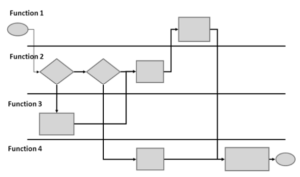The Importance of Process Definition
 Process definition and understanding the operational procedures of your business are imperative to success. While many executives see process definition as an exercise in futility, those who work in or on the process on a daily basis see firsthand how a poorly defined, inconsistent, and inefficient process can wreak havoc on productivity and quality. Moreover, those who boast that their company is working like a “well-oiled machine” rarely realize that their processes are often adapted by those who work in the process and these adaptations result in workarounds, quick fixes, and a reliance on the people who create them.
Process definition and understanding the operational procedures of your business are imperative to success. While many executives see process definition as an exercise in futility, those who work in or on the process on a daily basis see firsthand how a poorly defined, inconsistent, and inefficient process can wreak havoc on productivity and quality. Moreover, those who boast that their company is working like a “well-oiled machine” rarely realize that their processes are often adapted by those who work in the process and these adaptations result in workarounds, quick fixes, and a reliance on the people who create them.
Simplicity - Process Definition
There are many stages to learning and understanding your processes. The most basic starts with simplification and compressing your process into elementary steps expressed in a high-level process map. When looking at your process, first try to boil it down into simple, logical steps that are performed routinely. At this stage, you should be able to condense your process down to 4-6 steps. Clearly defining where the process starts, where it ends, and the critical few steps in between. Often, however, I find that clients make this very difficult. They declare that there are too many variables, too many exceptions, and the "if this, then that" confusion begins. This is where the ability to climb high and look at your process from a big-picture perspective becomes important. Any lack of definition or clarity by management about the essence of a process is exacerbated when the process is physically performed by people.
Basic High-Level Process Map
In order to establish your clear and basic process definition it's always advisable to start with a high-level process map with the intention to represent the process in as few steps as possible. Try to stick to 4-6 steps as a guideline but more importantly, keep it super simple. A couple of approaches work well. 1.) Start at the end. Identify your product or output and work backwards ignoring the confusing details (we'll address the details later, just not now). By starting at the end you keep your focus on the product of the process. Identify the function or activity that delivered the product, then identify the set of activities that preceded it, those steps can be aggregated into a logical group or function. Do this till you get to the beginning 2.) Another approach is of course to follow the product from the beginning. This is common but what is not so common is the ability to keep it simple. Again, aggregate activities in logical categories and define your high-level steps with those aggregated categories. 3.) Tricks to identifying key steps between beginning and end are to identify where transitions occur or where the business has decided to "measure". These are critical inflection points for a process and maybe points to call out on your high-level process map. Use the four basic shapes shown below for your map. These are universal process mapping symbols.

While there are many types of process maps, the high-level depiction above should be used to boil the current process down into its most fundamental state. If this proves to be a challenge you may not understand the process well enough or you're overcomplicating the objective. By achieving a solid high-level process map you'll be able to communicate it much more clearly to others and you'll be ready to move to the next stage of process definition which will eventually uncover more detail in a methodical and organized manner. Additionally, your high-level process map may serve you well with many other business management needs such as where you should be keeping key measurements if you're not already, where your resources should be allocated, and perhaps where your organization needs better alignment or greater support.
Now that you've achieved process definition in it's most basic form, you are ready to advance to a higher-order understanding. You will achieve this through more specific process definition tools such as a detailed process map, a functional process map, or a SIPOC. Eventually, you may even get to the Value Stream map which helps you understand many other facets of your process and your business.




